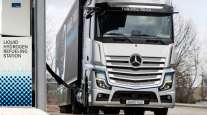Daimler Seeks to Boost Market Share, Says 2013 Shaping Up as Expected
This story appears in the March 4 print edition of Transport Topics.
LOS CABOS, Mexico — The chief salesman for North America’s largest truck manufacturer said 2013 thus far has been “pretty much exactly what we predicted” when company officials created their business projections last year.
Mark Lampert, senior vice president of sales and marketing for Daimler Trucks North America, told a press gathering here Feb. 21 that he expected industrywide sales would be within 10% of 2012’s final numbers. Last year, truck makers sold 194,715 Class 8 trucks in the United States, 13.6% more than 2011’s total.
Lampert said that regardless of the final tally, DTNA intends to further grow its market-leading share this year. The company’s Freightliner and Western Star heavy-duty brands captured 30.8% of the total sales in North American last year, compared with 29.2% in 2011.
“We want to grow market share in 2013,” Lampert said.
He said Freightliner and Western Star garnered 47% of all the Class 8 trucks sold in North America in January, a level he called unsustainable.
He said Freightliner sold more Classes 6-7 trucks last year than any other competitor for the first time ever. The brand had a market share of 36% in 2012, compared with 34.7% for the perennial sales leader in these classes, Navistar Inc.
Total U.S. Class 8 sales were down in January, trailing year-ago numbers by 6.8%, to the lowest total since mid-2011, even as DTNA was racking up an enormous share of the market.
Lampert also said that the company has orders for 9,300 of its newest heavy-duty model, the Cascadia Evolution, which is just beginning to roll off assembly lines.
This model is designed to be the company’s most fuel-efficient design and sports a number of aerodynamic and other fuel-saving features.
Lampert said there were no more “big things” available to truck makers to improve fuel efficiency for big trucks. Rather, he said, manufacturers will have to rely on a series of small improvements to secure additional fuel gain.
Meanwhile, DTNA officials said they were about halfway to the goal of the U.S. Department of Energy’s SuperTruck program, which is designed to produce a design for a heavy-duty vehicle that has a improved “freight efficiency” of 50%.
T.J. Reed, director of product strategy for Freightliner, said “we’re well on our way. We’re on our numbers.”
Under the five-year SuperTruck program, DTNA will receive some $40 million from DOE by 2014, and will match that amount. The goal is to improve miles per gallon for its Cascadia model from the 5.5 average recorded by its 2009 version, to 9.3 for the SuperTruck.
In comparison, the Cascadia Evolution model the company is introducing is averaging 6% better fuel efficiency for its fleet buyers than they were getting with 2012 model Cascadias, according to David Hames, general manager of marketing and strategy for DTNA.
The company has said it expects fleets to average about 7% better fuel efficiency than they got with their 2010 Cascadias.
DTNA President Martin Daum set 10 mpg as the company’s goal during a speech in March 2010.
Meanwhile, Hames said Freightliner has delivered more than 2,000 natural gas-powered trucks since 2008, more than any other truck maker.
He said a lack of fueling infrastructure remains as a key stumbling block to the growth of natural gas as a transportation fuel, and especially for liquefied natural gas.
Hames said the company has deployed five new natural gas-powered trucks for fleets around the nation to test. He said the company would soon begin offering Cascadia models with natural-gas engines.




